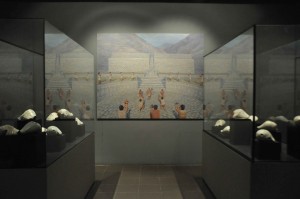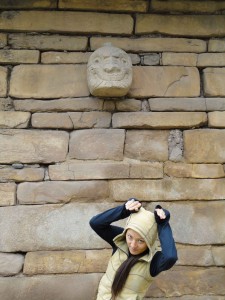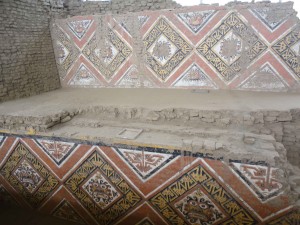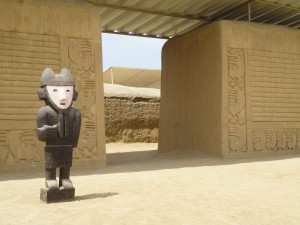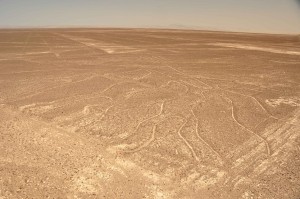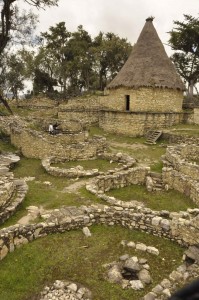Peru is one of those countries that I had never given much detailed consideration to really when it comes to ancient civilizations. Blinded by the myths and stories of the Inca’s I guess, I had kind of assumed that was all there was. Mexico was the same experience really, a place where the Mayan’s take all the glory and the many other civilizations seem to get left in the dark. But just like Mexico, it made Peru a constant surprise to travel, rich and diverse in its captivating, historical cultures some dating back more than 3,000 years, each building and improving on the other, many leaving mysterious legacies ripe for vivid speculations. It made for fascinating explorations.
While I can’t really cover them all and am skipping over a few here (like the Huari), there are many better sources out there anyway, so I’ve just jotted some of our highlights below;
Chavin:
One of the earliest major civilizations in Northern Peru is the mythical, shamanic, cat-worshipping Chavin culture. The Chavin empire once stretched from much of Peru’s Northern highlands and along the North and Central coasts and in many ways provided the building blocks for many of the subsequent civilizations. Artifacts dating back to 850BC, show that the Chavin were excellent artisans, with the dynamic and creative pottery styles very influential on later cultures, some almost picasso like. But it is the spiritual legacy of the Chavin which is probably most enduring.
The Chavin really consolidated the base for the Peruvian spiritual traditions that have continued in my forms through other subsequent cultures right up to today. Their worship of the 4 elements, mother nature and the great animal spirits, particularly the Puma, but also the condor and serpent were expressed in shamanic rituals using the San Pedro cactus. All these elements remain prominent in Andean spirituality today and is particularly evident in Inca & Andean mythology.
Visiting the great temple site of “Chavin de Huantar”, near Huarez was a special experience. The layout and architecture of the site as the spiritual home of the Chavin empire is magnificent, even though thousands of years old and crushed by landslides and earthquakes over time. The site features several sacred zones as you make your approach to the main temple – a large square, a divided black and white marble stairway and a circular ceremonial area where the priests performed their San Pedro ceremonies and rituals. The walls of the temples contained a series of sculpted heads surrounding the site, each showing a different stage of transformation from human to cat form. A pseudo demonstration if you will of the process the priests emulated in their San Pedro ceremonies, gaining access to the spiritworld and undergoing transformations. Many of the frescos, reliefs, pottery and sculptures found on the site are also amazing in documenting these experiences and beliefs. Inside the temple is a labyrinth of caves, tunnels and rooms, believed to be once have been an extensive network linking to other sites underground. One room contains a giant rock sculpture shaped like a knife, called the “Lanzon de Chavin”, it is carved into the shaped of an anthropomorphic deity with fangs, claws, serpentine features and other symbolic representations. The site is hard to get to and the tour guides mostly only speak Spanish, but if you have the background and the imagination it is really a very, special place to explore.
Moche:
Coming to the fore about 2,000 years ago, the Moche managed to tame the arid coastal regions, by implementing extensive irrigation systems throughout the coastal region, turning the arid desert landscape into fertile, agricultural zones – an important basic infrastructure built on and emulated by all later civilizations. Their pottery and ceramic ware was also to my mind the finest of all the great civilization of Peru bar the Chavin, with many mesmerizing and creative designs.
The best preserved site is near Trujillo on the Northern Coast of the Peru. Here two great pyramids, looking more like sand mountains these days given they were built more than 2,000 years ago, but known as the pyramid temples of the Moon and the Sun. The Temple of the Moon has been extensively excavated and sits near a brand new museum, one of the best we visited in South America. The Pyramid itself was rebuilt on top of the previous temple site numerous times, created multiple shells over the original site which has preserved much of the original temples, sculptures and reliefs. Some of the excavations we saw revealed really florid designs, incorporating designs of their god, Ai-Apaec plus other motifs including dragons, still vivid in their colour and paintwork. Further North, near Chiclayo (though we didn’t get there to visit) they have also found the great tombs of Sipan, burial chamber’s of a great lord of Moche, the tombs were rich with gold trinkets, ceramics revealing much about the culture.
Chimu:
The Chimu arrived on the scene about 850 AD conquered the Moche and then expanded their empire extensively right up until 1470 when they were in turn conquered by the Incan’s. The huge mud city of Chan Chan, supposed to be the largest mud city in the world, once housed some 10,000 inhabitants is also located just outside of Trujillo. It is a huge expanse of mud ruins, large walls, once up to 10m high, but still commanding in their size, run off in many directions enclosing large sections of the former city – its contents now reduced to mounds and little hills. The main centre has been partly restored and you can see some of the intricate designs built into the walls all along here – reliefs of fish, waves and other creatures. Its not particularly fascinating in itself, but the scale of the place is impressive to wander, some 20 square km of mud walls an ruins.
Nazca
The Nazca, were quite a mysterious people that lived in the Southern Coastal region from about 500 AD – 1,000 AD. While the distinctive style of their pottery is also interesting, it is the Nazca lines and geomorphic designs that abound upon the planes surrounding the area that is their real legacy.
The designs themselves are best seen from the air, although flights were too extortionate for us while we were there, due to a perfect storm of recently improved safety standards, a lack of approved companies and then no petrol supplies – a total sellers market. The designs extend for hundreds of kilometres in every direction and mystify with their purpose or intent. There are fantastic animal designs (monkeys, hummingbirds), a spacemen and other more simple geometric shapes and straight lines that extend over huge distances. The why is still a mystery – part of a rain / fertility rituals perhaps, landing strips for aliens or complex constellation maps – there are innumerable fantastic theories and it’s a great place to let your imagination run wild. But honestly the town is not much and while there are a couple of look outs to view things from, you can’t really see or experience it, if you don’t pay the money and take the flight.
Chachapoyas:
The warrior Chachapoyan culture of the Northern highlands, later conquered by the Incan’s, also left some amazing legacies spread across their remote mountain locations. The biggest site is the huge fortress ruin of Kuelap, a stunning architectural achievement, an entire city built on the top of a mountain and extremely well designed. Inside the fortress walls, there are several, well preserved village’s layouts, each based around a central Shaman main house, each displaying unique totems in their wall design. It is difficult to get to, but the wild several hour ride up through the winding mountain roads and villages, makes the journey particularly special – one of the best adventures, views and experiences to be had, despite the blisters.
Also dotted throughout the surrounding mountains are hidden all manner of smaller legacies – hidden temples, villages built into the sides of the mountains and several different sculptured sarcophagi containing mummies placed into amazing locations in the side of mountains. Off the beaten track, often undocumented, friendly people and cheap, with spectacular landscapes everywhere – the Chachapoyas region was one of the most pleasant and enjoyable places to explore that we visited in Peru.
![Discovering Peru’s Ancient Civilizations Peru is one of those countries that I had never given much detailed consideration to really when it comes to ancient civilizations. Blinded by the […]](http://meltingplots.com/wp-content/uploads/2011/02/Top2.jpg)
